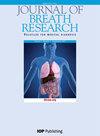Discovery and Analysis of the Relationship between Organic Components in Exhaled Breath and Bronchiectasis.
IF 3.4
4区 医学
Q1 BIOCHEMICAL RESEARCH METHODS
引用次数: 0
Abstract
The prevalence of patients with bronchiectasis (BE) has been rising in recent years, which increases the substantial burden on the family and society. Exploring a convenient, effective, and low-cost screening tool for the diagnosis of BE is urgent. We expect to identify the accuracy of breath biomarkers(BBs) for the diagnosis of BE through breathomics testing and explore the association between BBs and clinical features of BE. Method: Exhaled breath samples were collected and detected by high-pressure photon ionization time-of-flight mass spectrometry(HPPI-TOF MS) in a cross-sectional study. Exhaled breath samples were from 215 patients with BE and 295 control individuals. The potential BBs were selected via the machine learning method. The overall performance was assessed for the BBs-based BE detection model. The significant BBs between different subgroups such as the severity of BE, acute or stable stage, combined with hemoptysis or not, with or without Nontuberculous Mycobacterium (NTM), Pseudomonas aeruginosa (P.a) isolation or not, and the BBs related to the number of involved lung lobes and lung function were discovered and analyzed. Results: The top 10 BBs based machine learning model achieved an area under the curve (AUC) of 0.940, sensitivity of 90.7%, specificity of 85%, and accuracy of 87.4% in BE diagnosis. Except for the top ten BBs, other BBs were found also related to the severity, acute/stable status, hemoptysis or not, NTM infection, P.a isolation, the number of involved lobes, and three lung functional paramters in BE patients. Conclusions: BBs-based BE detection model showed good accuracy for diagnosis. BBs have a close relationship with the clinical features of BE. The breath test method may provide a new strategy for bronchiectasis screening and personalized management. Clinical Trail Number: NCT05293314 .发现和分析呼出气体中的有机成分与支气管扩张症之间的关系
近年来,支气管扩张症(BE)患者的发病率不断上升,这加重了家庭和社会的沉重负担。探索一种方便、有效、低成本的支气管扩张症筛查工具迫在眉睫。我们希望通过呼吸组学检测确定呼吸生物标志物(BBs)诊断 BE 的准确性,并探讨 BBs 与 BE 临床特征之间的关联:在一项横断面研究中收集呼出气体样本,并通过高压光子电离飞行时间质谱(HPPI-TOF MS)进行检测。呼气样本来自 215 名 BE 患者和 295 名对照组个体。通过机器学习方法筛选出潜在的BB。评估了基于BBs的BE检测模型的整体性能。发现并分析了不同亚组(如 BE 的严重程度、急性期或稳定期、是否合并咯血、有无非结核分枝杆菌(NTM)、铜绿假单胞菌(P.a)分离与否)之间的重要 BBs,以及与受累肺叶数量和肺功能相关的 BBs:基于前 10 个 BBs 的机器学习模型在 BE 诊断中的曲线下面积(AUC)为 0.940,灵敏度为 90.7%,特异度为 85%,准确率为 87.4%。除排名前十的 BBs 外,其他 BBs 也与 BE 患者的严重程度、急性/稳定状态、咯血与否、NTM 感染、P.a 分离、受累肺叶数和三个肺功能参数有关:基于 BBs 的 BE 检测模型显示出良好的诊断准确性。BBs与BE的临床特征有密切关系。呼气试验方法可为支气管扩张症筛查和个性化管理提供新策略:NCT05293314
.
本文章由计算机程序翻译,如有差异,请以英文原文为准。
求助全文
约1分钟内获得全文
求助全文
来源期刊

Journal of breath research
BIOCHEMICAL RESEARCH METHODS-RESPIRATORY SYSTEM
CiteScore
7.60
自引率
21.10%
发文量
49
审稿时长
>12 weeks
期刊介绍:
Journal of Breath Research is dedicated to all aspects of scientific breath research. The traditional focus is on analysis of volatile compounds and aerosols in exhaled breath for the investigation of exogenous exposures, metabolism, toxicology, health status and the diagnosis of disease and breath odours. The journal also welcomes other breath-related topics.
Typical areas of interest include:
Big laboratory instrumentation: describing new state-of-the-art analytical instrumentation capable of performing high-resolution discovery and targeted breath research; exploiting complex technologies drawn from other areas of biochemistry and genetics for breath research.
Engineering solutions: developing new breath sampling technologies for condensate and aerosols, for chemical and optical sensors, for extraction and sample preparation methods, for automation and standardization, and for multiplex analyses to preserve the breath matrix and facilitating analytical throughput. Measure exhaled constituents (e.g. CO2, acetone, isoprene) as markers of human presence or mitigate such contaminants in enclosed environments.
Human and animal in vivo studies: decoding the ''breath exposome'', implementing exposure and intervention studies, performing cross-sectional and case-control research, assaying immune and inflammatory response, and testing mammalian host response to infections and exogenous exposures to develop information directly applicable to systems biology. Studying inhalation toxicology; inhaled breath as a source of internal dose; resultant blood, breath and urinary biomarkers linked to inhalation pathway.
Cellular and molecular level in vitro studies.
Clinical, pharmacological and forensic applications.
Mathematical, statistical and graphical data interpretation.
 求助内容:
求助内容: 应助结果提醒方式:
应助结果提醒方式:


